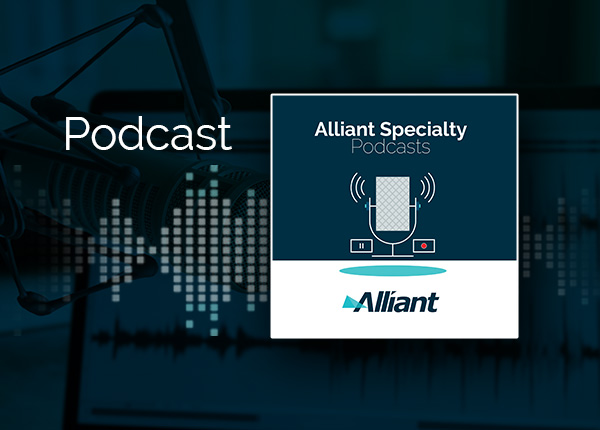Specialty Podcast: Why Alternative Risk Transfer (ART) Solutions are in High Demand
By Alliant Specialty
While Alternative Risk Transfer (ART) solutions have been around for decades, the current market landscape and the ability for companies of all sizes to now take advantage of ART solutions, has brought innovative risk financing to the forefront.
Alex Littlejohn sits down with Peter Kranz who will spearhead Risk Finance and Strategic Consulting solutions at Alliant to discuss what is driving the need for more creative ways to finance risk and how he will help clients explore options outside of traditional insurance offerings.
Intro (00:00):
You're listening to the Alliant Specialty Podcast, dedicated to insurance and risk management solutions and trends shaping the market today.
Alex Littlejohn (00:08):
Welcome to another Alliant Specialty Podcast. I'm Alex Littlejohn with Alliant P&C. And today with me is Pete Kranz. Pete joined us recently and we're very, very excited to have him here. He's going to lead our efforts in alternative risk. Welcome aboard, Pete.
Pete Kranz (00:25):
Thank you very much, Alex. I'm very excited to join Alliant. So, I come from 10 years in traditional public accounting. And the reason why I say traditional is it's not strictly insurance. So, my exposure to a lot of different industries, public accounting, you had all the audits, tax, financial projection, engagements, business valuations, all that sort of stuff, which really led to the last three to four years of that time doing consulting that then led me into the risk management and risk financing world. Spent about 17 and a half years in captive management and consulting most recently leading a management consulting practice for the past four years. So quite a bit of experience there. Now most of that time, even towards the end, towards the last several years of that, we're focused on risk financing, not just captives, because captives are part of the risk financing world, but it's not the overall solution. There should be a much broader solution that's looked at.
Alex Littlejohn (01:22):
Terrific, and so, you know, that's just such an incredible and expansive experience. I know that our clients and prospects are going to benefit from that. So, give us a little bit of an idea of what you're going to focus on here at Alliant.
Pete Kranz (01:33):
Yeah, my goal is to build a consolidated practice, to focus on risk finance and strategic consulting. And the reason why I say risk finance and strategic consulting, I'll talk shortly about the strategic consulting side, is there's a lot of different programs and things that can be set up that can support the risk financing objective but may not be directly the risk financing program structure itself. So, when we talk about the risk financing component of it, it's really coming in and bringing together all the resources. So, the actuarial, you know, being able to look at things from a, you know, deterministic versus stochastic modeling looking at things from a confidence level, so that as you're looking at a program structure, you can look at potential savings and evaluate that against the risk that's being taken and actuarily the one in 10, one in 20-year event to determine if it's worth it. So, it's that piece in addition to that, and this is where, you know, there could be some benefit from captives, right? Is, you know, does it make sense to finance it into a captive? And can you increase retentions? Outside finance the risk into a captive, do integrated aggregates, do multiline. But then we've got other things, right? You've got, you know, ILS insurance link securities. It's not very accessible at the moment to individual organizations, but it's a piece that traditional markets are using, right? Traditional markets and reinsurance markets to transfer care risk. Well, most of the things that, that we look at from a business level today are things that evolved from that. So those ILS, you know, there are some programs out there that are starting to try to make that more accessible with captives, and we've done some programs with captives or with smaller single insureds, right? So, it's really trying to access those ILS, make sure that we bring forward parametric programs, you know, really looking at the full suite of potential risk financing options to find the most efficient structure for each organization.
Alex Littlejohn (03:31):
Well, you know, it couldn't happen at a better time, Pete, right? This has been going, you know, the market hardening over the last several years, all of us talking about those issues with our clients and our clients, quite frankly, being, you know, forced in some cases to look at different methods of risk and how that risk is structured, financed and what alternatives are out there. So, you know, I don't see, I mean, I see that the market is starting to, you know, respond a bit better, but you know, you just don't unravel from that. And clients, I think having had the taste, are only going to go deeper and deeper into looking at alternatives and figuring out how they can best transfer their risk or retain their risk. So, you know, I think if you want to add on, please, to what's driving the need around this industry. However, the last couple years, the hardening market has had effect in looking at more creative ways to risk finance.
Pete Kranz (04:23):
I think, you actually hit on it, is there's a good that comes out of this, which is tough for a lot of organizations. When you see "why are my premiums going up 40, 50, or 100% or 200%", but really this hardening market seems to be a bit different from those in the past. So, what we had in the past is, you know, companies would go out, they'd get their pricing and oh, no, we've got a 40% premium increase. There'd be some pushback, a little bit of negotiation and you bring it down and you get us to 20% or 18% or whatever it has to be something slightly more parable. What we saw through this hardening market was markets simply walking away saying, look, this is our pricing. And if you don't want it, we don't need to fill out our capacity. So, from the underwriting side, they had far less motivation or drive to fill their capacity than they did to just chase rate. There's an anecdote out there from one of the leaders of a carrier. I won't get into the names just in case I get it wrong. I think the point is really relevant. He went into his underwriting team, and he said, you know, what was our retention? And the underwriting team said 95%, we did fantastic this year. And he said, no, that's crazy. We shouldn't be at 95%. We should be at 50% or 60%. I only want to keep the good business. I don't want the bad business. And that sort of encapsulates to me, what's happened through this market. The other thing though is with these premium pricing increases with this forced increased retention, forced exclusions, and covers limitations. A lot of things have happened that are sort of a little bit outside. The insurance piece within organizations is things have moved from risk management to CFO. There's far more intention at the finance and CFO level and, you know, risk managers, obviously they're in the business of mitigating risk. See they need the support of CFOs within organizations to take a more creative approach. So, this getting the attention of CFOs - major, major positive, because the CFO is going to support the risk manager fully in whatever decisions are made. They’re going to understand a lot of the concepts where we're looking and saying, look, I don't care if you're taking a 250,000 or 500,000, a million-dollar retention on workers comp, they're going to say, what is my total cost of risk? And on the volatility part, what controls can we put in place to mitigate volatility? This is where we need to go is- we need to be far more creative in how risk is financed
Alex Littlejohn (06:48):
Well said. And I think that getting that message out to our clients, through our prospects, through the Alliant network, coupled with the analytics that we're building from that perspective, that discuss risk tolerance and the flexibility within it and what the insured is able to actually retain in way of risk or look way in alternative structure, very, very exciting stuff. And so let our listeners know, you know, what our clients and our prospect could expect. And if you could just give us that kind of perspective, and then we'll wrap it up, Pete.
Pete Kranz (07:19):
Absolutely. So really in summary, what I'm going to do is I'm going to work with clients to evaluate and quantify their risk tolerance and appetite, which is a very important piece to all this. That's where that volatility comes in and then work to design programs that provide the most efficient and effective retentions and transfers of risk. And so, I'm going to support the producers and brokers of Alliant, you know, working with their clients and prospects, and really focus on delivering the best solution.
Alex Littlejohn (07:48):
Perfect. And thanks, Pete. I think this wraps it up. If you'd like more information, please follow us at www.alliant.com.
Alliant note and disclaimer: This document is designed to provide general information and guidance. Please note that prior to implementation your legal counsel should review all details or policy information. Alliant Insurance Services does not provide legal advice or legal opinions. If a legal opinion is needed, please seek the services of your own legal advisor or ask Alliant Insurance Services for a referral. This document is provided on an “as is” basis without any warranty of any kind. Alliant Insurance Services disclaims any liability for any loss or damage from reliance on this document.
Thanks for your message.
We’ll be in touch shortly.



